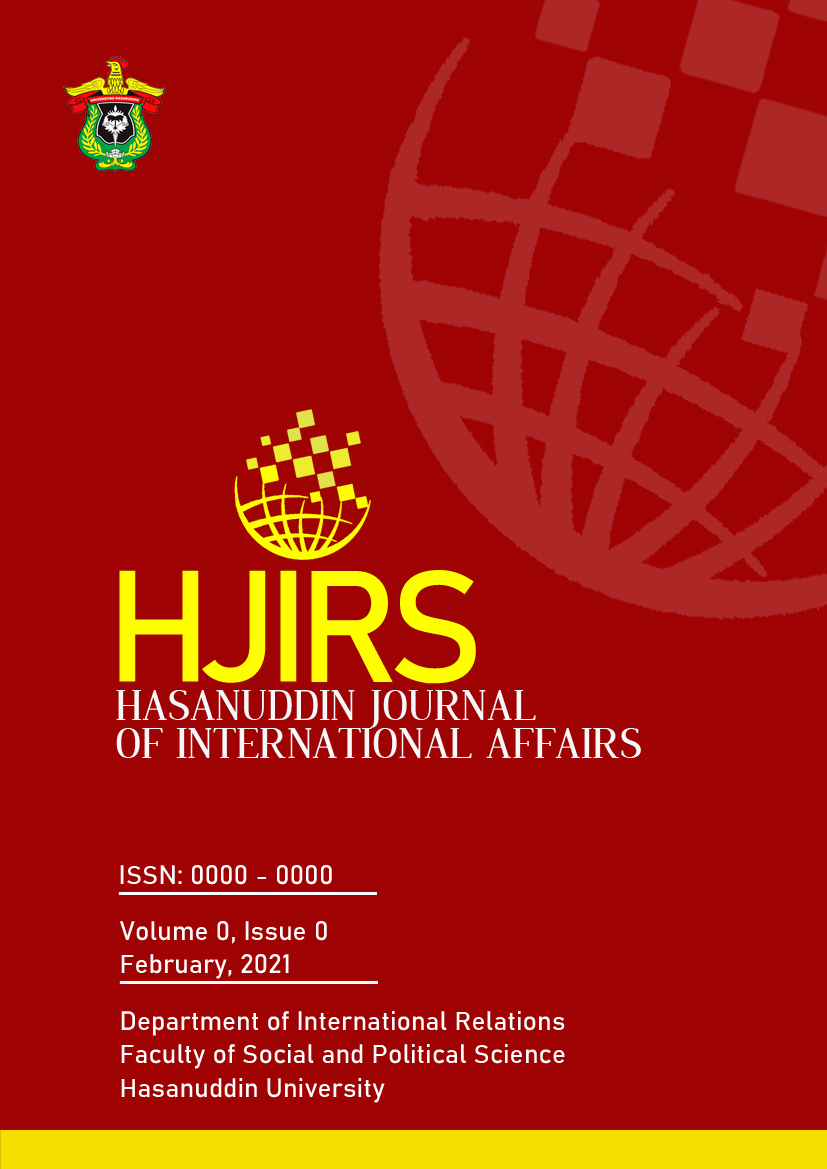Main Article Content
Abstract
This research was conducted to understand the implementation of models and factors that influence China's Good Neighbor Policy decision making during the reign of Hu Jintao in the Greater Mekong Sub-Region. By using an Adaptive decision-making model, this paper tries to describe the internal and external factors that influenced President Hu Jintao to choose a model of revitalization of cooperation and infrastructure development as well as economic corridors as a manifestation of the implementation of the Good Neighbors policy in GMS. This study used a qualitative approach and used secondary data as the source of the analyzed data.
Penelitian ini dimaksudkan untuk memahami model implementasi dan faktor yang mempengaruhi pengambilan keputusan pelaksanaan kebijakan Tetangga baik (Good Neighbour Policy) China Pada Masa pemerintahan Hu Jintao di Greater Mekong Sub Region. Dengan menggunakan model pemgambilan keputusan Adaptif, tulisan ini mencoba mendeskripsikan faktor internal dan ekternal yang mempengaruhi Presiden Hu Jintao memilih model revitalisasi kerjasama dan pembangunan infrastruktur serta koridor ekonomi sebagai wujud implementasi kebijakan Tetangga yang Baik di GMS. Penelitian ini menggunakan pendekatan kualitatif dan menggunakan data sekunder sebagai sumber data yang dianalisis.
Article Details
References
- Abdullah, N. (2016). Analisis geopolitik kebijakan ekonomi China di Greater Mekong Sub-region (GMS) Pada Masa Pemerintahan Hu Jintao 2003-2013. Yogyakarta: UGM.
- ADB. (2007). Join Ministrerial Statement: 14th Ministerial Conference . ADB.
- ADB. (2008). Joint summit Declaration: 3rd GMS Summit of Leaders. ADB.
- Beck, E. R. (1939). The Good Neighbor Policy, 1933-1938. The Historian, 110-131.
- Centre of Policy Analysis and Development for Asia-Pasifik and African Regions. (2011). ASEAN connectuvity in Indoneisa Context: A Preliminary Study on Geopolities of Hydropower and Maritim Transport. Jakarta: Ministry of Foreign Affairs of the Republic of Indonesia.
- Chien-peng Chung. (2010). China's Multilateral Cooperation in Asia and the Pasific-institutionalizing Beijing "Good Neighbour Policy". New York: Routledge.
- Cipto, B. (2002). Dinamika Hubungan Internasional Pasca Perang Dingin Dan Implikasinya Terhadap Peran Umat Islam Di Indonesia. Tarjih-Jurnal Tarjih dan Pengembangan Pemikiran Islam , 17-28.
- East Asian Institute at the National University of Singapore. (2018). China's Active Role in The Greater Mekong Sub-Region: "A win win Outcome". East Asian Institute at the National University of Singapore.
- Hayati Nufus, C. L. (2018). Peran dan Kepentingan Tiongkok dalam Greater Mekong Sub-Region . In A. Irewati, Dinamika Kerjasama Sub-Regional di Asia Tenggara : Greater Mekong Sub-Region (pp. 71-108). Jakarta: LIPI Press .
- Lanteigne, M. (2009). China's Foreign Policy: An Introduction. New York: Routledge.
- Mochamad, A. A. (2006). Pengantar Ilmu Hubungan Internasional . Bandung: PT. Remaja Rosdakarya.
- National Development and Reform Commision of the People's Republic of China. (2008). Country Report on China Participation in Greater mekong Sub-region Cooperation. Beijing: National Development and Reform Commision of the People's Republic of China.
- Ndembei, E. (2015). Bantuan Luar Negeri Tiongkok untuk pembangunan Infrastruktur Kenya. In S. Djelantik, Asia Pasifik: Konflik, kerjasama, dan Relasi antar Kawasan (pp. 321-342). Jakarta: Yayasan Pustaka Obor Indonesia .
- Teresita Cruz-del Rosario. (2010). Lessons in Regional Economic Cooperation: The case of the Greater Mekong Sub-Region (GMS). Lee Kuan Yew School of Public Policy , 1-15.
- Zhenming, Z. (2010). Mekong Development and China’s (Yunnan) Participation in the Greater Mekong Sub-region Cooperation. Ritsumeikan International Affairs, 1-16.
References
Abdullah, N. (2016). Analisis geopolitik kebijakan ekonomi China di Greater Mekong Sub-region (GMS) Pada Masa Pemerintahan Hu Jintao 2003-2013. Yogyakarta: UGM.
ADB. (2007). Join Ministrerial Statement: 14th Ministerial Conference . ADB.
ADB. (2008). Joint summit Declaration: 3rd GMS Summit of Leaders. ADB.
Beck, E. R. (1939). The Good Neighbor Policy, 1933-1938. The Historian, 110-131.
Centre of Policy Analysis and Development for Asia-Pasifik and African Regions. (2011). ASEAN connectuvity in Indoneisa Context: A Preliminary Study on Geopolities of Hydropower and Maritim Transport. Jakarta: Ministry of Foreign Affairs of the Republic of Indonesia.
Chien-peng Chung. (2010). China's Multilateral Cooperation in Asia and the Pasific-institutionalizing Beijing "Good Neighbour Policy". New York: Routledge.
Cipto, B. (2002). Dinamika Hubungan Internasional Pasca Perang Dingin Dan Implikasinya Terhadap Peran Umat Islam Di Indonesia. Tarjih-Jurnal Tarjih dan Pengembangan Pemikiran Islam , 17-28.
East Asian Institute at the National University of Singapore. (2018). China's Active Role in The Greater Mekong Sub-Region: "A win win Outcome". East Asian Institute at the National University of Singapore.
Hayati Nufus, C. L. (2018). Peran dan Kepentingan Tiongkok dalam Greater Mekong Sub-Region . In A. Irewati, Dinamika Kerjasama Sub-Regional di Asia Tenggara : Greater Mekong Sub-Region (pp. 71-108). Jakarta: LIPI Press .
Lanteigne, M. (2009). China's Foreign Policy: An Introduction. New York: Routledge.
Mochamad, A. A. (2006). Pengantar Ilmu Hubungan Internasional . Bandung: PT. Remaja Rosdakarya.
National Development and Reform Commision of the People's Republic of China. (2008). Country Report on China Participation in Greater mekong Sub-region Cooperation. Beijing: National Development and Reform Commision of the People's Republic of China.
Ndembei, E. (2015). Bantuan Luar Negeri Tiongkok untuk pembangunan Infrastruktur Kenya. In S. Djelantik, Asia Pasifik: Konflik, kerjasama, dan Relasi antar Kawasan (pp. 321-342). Jakarta: Yayasan Pustaka Obor Indonesia .
Teresita Cruz-del Rosario. (2010). Lessons in Regional Economic Cooperation: The case of the Greater Mekong Sub-Region (GMS). Lee Kuan Yew School of Public Policy , 1-15.
Zhenming, Z. (2010). Mekong Development and China’s (Yunnan) Participation in the Greater Mekong Sub-region Cooperation. Ritsumeikan International Affairs, 1-16.
